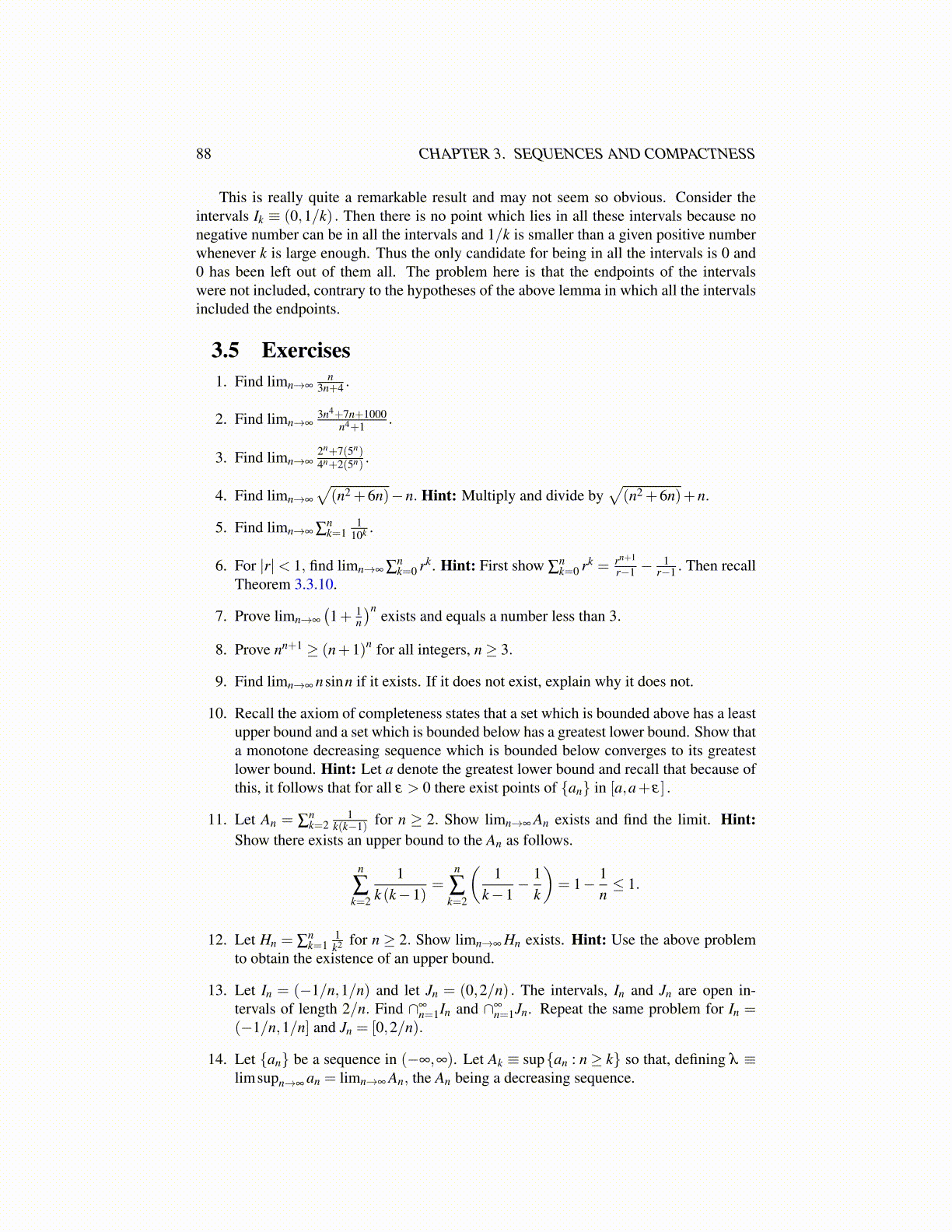
88 CHAPTER 3. SEQUENCES AND COMPACTNESS
This is really quite a remarkable result and may not seem so obvious. Consider theintervals Ik ≡ (0,1/k) . Then there is no point which lies in all these intervals because nonegative number can be in all the intervals and 1/k is smaller than a given positive numberwhenever k is large enough. Thus the only candidate for being in all the intervals is 0 and0 has been left out of them all. The problem here is that the endpoints of the intervalswere not included, contrary to the hypotheses of the above lemma in which all the intervalsincluded the endpoints.
3.5 Exercises1. Find limn→∞
n3n+4 .
2. Find limn→∞3n4+7n+1000
n4+1 .
3. Find limn→∞2n+7(5n)4n+2(5n) .
4. Find limn→∞
√(n2 +6n)−n. Hint: Multiply and divide by
√(n2 +6n)+n.
5. Find limn→∞ ∑nk=1
110k .
6. For |r|< 1, find limn→∞ ∑nk=0 rk. Hint: First show ∑
nk=0 rk = rn+1
r−1 − 1r−1 . Then recall
Theorem 3.3.10.
7. Prove limn→∞
(1+ 1
n
)nexists and equals a number less than 3.
8. Prove nn+1 ≥ (n+1)n for all integers, n ≥ 3.
9. Find limn→∞ nsinn if it exists. If it does not exist, explain why it does not.
10. Recall the axiom of completeness states that a set which is bounded above has a leastupper bound and a set which is bounded below has a greatest lower bound. Show thata monotone decreasing sequence which is bounded below converges to its greatestlower bound. Hint: Let a denote the greatest lower bound and recall that because ofthis, it follows that for all ε > 0 there exist points of {an} in [a,a+ ε] .
11. Let An = ∑nk=2
1k(k−1) for n ≥ 2. Show limn→∞ An exists and find the limit. Hint:
Show there exists an upper bound to the An as follows.
n
∑k=2
1k (k−1)
=n
∑k=2
(1
k−1− 1
k
)= 1− 1
n≤ 1.
12. Let Hn = ∑nk=1
1k2 for n ≥ 2. Show limn→∞ Hn exists. Hint: Use the above problem
to obtain the existence of an upper bound.
13. Let In = (−1/n,1/n) and let Jn = (0,2/n) . The intervals, In and Jn are open in-tervals of length 2/n. Find ∩∞
n=1In and ∩∞n=1Jn. Repeat the same problem for In =
(−1/n,1/n] and Jn = [0,2/n).
14. Let {an} be a sequence in (−∞,∞). Let Ak ≡ sup{an : n ≥ k} so that, defining λ ≡limsupn→∞ an = limn→∞ An, the An being a decreasing sequence.